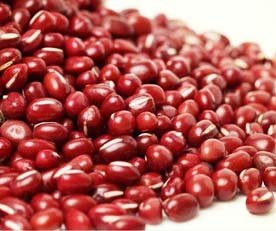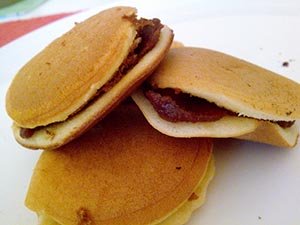Adzuki beans Nutrition facts
Adzuki beans (Chinese red beans) (アズキ) are the leguminous fruit pods of a plant originally from Asia. The beans occupy a significant cultural importance in oriental cuisine. The red-colored beans were believed to have the effect of suppressing negative emotions and bad luck.
Binomially, red beans belongs to the Fabaceae family, in the genus: Vigna.
Scientific name: Vigna angularis
 |
| Chinese red beans (Adzuki). |
Adzuki bean is an herbaceous annual. It has similar climate and soil requirements as soybeans. About two months after seedling, the plant produces yellow flowers, which develop into elongated, cylindrical, smooth-skinned pods in clusters in the next 40 days.
Adzuki bean pods hold tiny seeds that are brownish-red but can also be black, light yellow, or gray. They can be plain or variegated and have a prominent white hilum (the ridge where the bean was connected to the pod).
Boiled beans feature a nutty, buttery texture and sweet flavor.
Health benefits of Adzuki beans
Adzuki beans are one of the important sources of plant-based proteins. 100g beans hold 329 calories and provide 19.87 g or 35% of the recommended daily allowance of protein.
Red vigna beans contain antioxidants such as isoflavones and pro-anthocyanidins in ample amounts. The total value of isoflavones is 0.59 mg per 100 grams of beans; daidzein and genistein at levels 0.36 mg and 0.23 mg respectively. Isoflavones have been found to reduce post-menopausal cancers and osteoporosis.
Like other legumes, adzuki beans contain lots of dietary fiber. Dietary fiber works as a bulk laxative that helps to protect the colon mucosa by decreasing its exposure time to toxic substances as well as by binding to cancer-causing chemicals in the colon. Dietary fiber has also been shown to reduce blood cholesterol levels by decreasing the reabsorption of cholesterol-binding bile acids in the colon.
Plant sterols (phytosterols) especially β-sitosterol that help lower cholesterol levels in the body.
Fresh, as well as dry adzuki are one of the finest sources of folates. They carry more of this vitamin than lima, soy or fava beans. 100 g dry, mature beans provide 622 µg or 155% of folates.
Folate, along with vitamin B-12, is one of the essential co-factors for DNA synthesis and cell division. Adequate folate in the diet around conception and during pregnancy may help prevent neural tube defects in the newborn baby.
Red beans indeed are very rich sources of many B-complex vitamins, particularly vitamin-B6 (pyridoxine), thiamin (vitamin B-1), pantothenic acid, riboflavin, and niacin. Most of these vitamins work as co-factors for the enzymes in carbohydrate, protein, and fat metabolism.
In addition, adzuki is composed wide range of minerals from being low in calcium -6% of RDA to high levels such as 64% RDA of iron, 75% of manganese, 54% of phosphorus, 36% of manganese and 27% of potassium.
Potassium is an essential electrolyte of cells and body fluids. It helps counter the pressing effects of sodium on heart and blood pressure. The human body uses manganese as a co-factor for the important antioxidant enzyme, superoxide dismutase.
| Principle | Nutrient Value | Percent of RDA |
|---|---|---|
| Energy | 329 Kcal | 16% |
| Carbohydrates | 62.90 g | 48% |
| Protein | 19.87 g | 35% |
| Total Fat | 0.53 g | 2.8% |
| Cholesterol | 0 mg | 0% |
| Dietary Fiber | 12.7 g | 33% |
| Vitamins | ||
| Folates | 622 μg | 155.5% |
| Niacin | 2.630 mg | 16% |
| Pantothenic acid | 1.471 mg | 29% |
| Pyridoxine | 0.351 mg | 27% |
| Riboflavin | 0.220 mg | 17% |
| Thiamin | 0.455 mg | 38% |
| Vitamin A | 17 IU | 0.5% |
| Vitamin C | 0 mg | 0% |
| Electrolytes | ||
| Sodium | 5 mg | <1% |
| Potassium | 1254 mg | 27% |
| Minerals | ||
| Calcium | 66 mg | 6.6% |
| Copper | 1.094 μg | 12% |
| Iron | 4.98 mg | 62% |
| Magnesium | 127 mg | 32% |
| Manganese | 1.730 mg | 75% |
| Phosphorus | 381 mg | 54% |
| Selenium | 3.1 μg | 5.6% |
| Zinc | 5.04 mg | 45% |
Selection and storage
In the markets, choose dried beans. Although their color pattern would not come in the way of quality, adzuki (red) beans are often preferred in cooking. In the US markets, dried beans in bulk bins, and canned, sprouted adzuki are available in the supermarkets all around the year.
Young, green adzuki pods sold in the Chinese and Korean markets are used much like green beans in cooking. While buying tender adzuki from the local vegetable markets, look for green, uniformly developed, immature, firm pods. Avoid over-mature pods as the beans prime their age and convert their sugars into starch. Also avoid sunken, shriveled pods.
At home, store dry beans in an air-seal plastic/metallic bin in a cool, dry place away from high temperatures and high humidity.
Young tender pods, however, treated like edamame or green beans for storage. Store them in a perforated plastic bag and place them in the refrigerator set at high relative humidity. They stay well for up to 4-6 days. To enjoy, however, use them soon after the purchase.
Preparation and serving methods
Dry adzuki beans are most sought after in the Japan cuisine only after soybeans. Boiled beans exhibit a rich red color and delicately nutty, sweet flavor.
Cooking often requires soaking in cold water for 2-3 hours. The beans can also be boiled and simmer for 1.5 to 2 hours. Or Pressure cooked with soaking for 20 minutes and without soaking for 20-30 minutes. Soaking and boiling also help eliminate anti-nutritional compounds in the red beans.
To prepare, wash fresh green azuki pods in cold running water. To shell, snap the calyx end towards the midrib and pull all along the suture line as you do for other bean pods. Split open and remove beans.
Here are some serving tips:
 |
| Dorayaki-Japanese styled pancakes with anko (red bean) paste filling. Photo credit: tisay |
Immature adzuki bean pods are used in the same way as green beans and generally treated like vegetables.
Dry beans employed in a wide range of dishes boiled, sprouted, popped, mashed (paste).
The beans are added in soups, stews mixed with other complementing vegetables like kale, carrots, mushrooms, etc.
Sekihan (赤飯) is the traditional Japanese sticky rice and adzuki beans dish prepared for special occasions such as shichi-go-san.
Boiled adzuki beans prepared into different styles of paste (an or anko) for use in both savory and sweet dishes. Koshian is the most common type in which boiled beans are sieved to remove bean skins. Tsubushian is where the beans are mashed after boiling and bean skins are a part of the paste.
-
Known as red choti dal in India, the beans are used in various kinds of savory stews to be eaten with unleavened flatbread (chapati), and rice.
Safety profile
Adzuki beans indeed are one of the low oxalate foods among the beans. Just 4.7 mg per 100 g when compared to 7.5 mg of broad beans, and 45.6 mg for kidney beans. Oftentimes, sprouted adzuki may cause cramp pain in the stomach, diarrhea, and vomiting. (Medical disclaimer)
Also read ≻≻
≺≺ Lima beans nutrition facts and health benefits.
≺≺ fava beans nutrition facts and health benefits.
≺≺ Back to Legumes from Adzuki Beans. Visit here for an impressive list of vegetables with complete illustrations of their nutrition facts and health benefits.
≺≺ -Back to Home page.
Further Resources:
Stanford School of Medicine Cancer information Page- Nutrition to Reduce Cancer Risk.